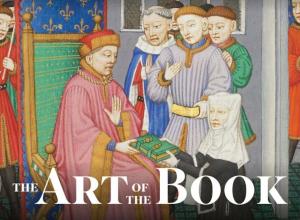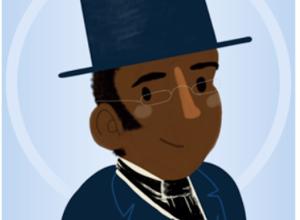Bright Young Librarians: Earle Havens
Our series profiling the next generation of special collections librarians and curators continues today with Earle Havens, the William Kurrelmeyer Curator of Rare Books & Manuscripts at Johns Hopkins University.
How did you get started in rare books?
My undergraduate mentor, an inveterate bibliomane, Professor Kate Frost, brought me to the Harry Ransom Center when I was a Sophomore. She arranged for me to see the Cardigan Chaucer, a mid 15th-century Middle English manuscript. She asked me what I saw. I said: "I didn't know any of this stuff had ever survived. How?" Her answer: "That's what libraries do." I wrote several of my undergraduate essays from rare books at the HRC. When it came time to graduate, I asked her where I should go to be a perpetual student of books. She told me: "Go get a PhD at the university with the best rare book library." I wanted to study the Renaissance. I went to Yale, got a job in my first year as a curatorial assistant to Dr. Stephen Parks, Curator of the Osborn Collection at the Beinecke Library, and discovered my dissertation on the shelves (I had stack access to the Beinecke Library all through graduate school...I highly recommend it!), and the rest is history. All of it has been an absolute privilege. Now that I have students of my own at Johns Hopkins University, I do all that I can to give them the same opportunity that I had, lo those many years ago.
Where did you earn your MLS or other advanced degree?
I am not a "librarian" in the sense of the MLS, which is actually a degree that is changing to IS ("information school") with library as a bit of a sidelight. I did a PhD at Yale University in History and Renaissance Studies, a joint-degree program like Classics, where you take all sorts of courses on a specific period of time: history of art, Romance languages, theology, historiography, etc. I focused on the history of the book in those periods. Many of my papers were written on Renaissance manuscripts that the Beinecke had just acquired! If you don't want to keep trying to cook up clever things to say about Shakespeare, just transcribe and edit Renaissance verse that no one has ever seen before! Heady days.
What is your role at your institution?
I am responsible for all rare books and manuscripts that pre-date the modern era, so ancient Babylonian cuneiform tablets and Ptolemaic Egyptian papyri to medieval illuminated manuscripts, incunabula, onwards to the late 18th c and the last gasp of the Ancien Regime. We have three rare books libraries: (1) the George Peabody Library, a magnificent 19th c. "cathedral of books" in downtown Baltimore; (2) the John Work Garrett Library at Evergreen, a 19th-century Gilded Age Renaissance Revival mansion in north Baltimore; and (3) the Brody Learning commons, our newly built rare book facility on the main campus. I also teach 2 full courses each year, one to undergraduates, the other a graduate-student seminar, which I conduct largely from rare books and manuscripts in a special classroom. Teaching young people about old books is the most meaningful thing I have ever done. We teach each other, in truth, through a magical confection of questions, hypotheses, discoveries, and pure giddiness at the immediate presence of the distant past. I have to pinch myself sometimes. Young people breath life into books, books into them. It's like trees turning carbon dioxide into oxygen. New knowledge from old books. School was always meant to be that way, wasn't it?
Favorite rare book / ephemera that you've handled?
I hate this question. Curators' favorites are not like favorite sons. We are fickle, and dazzled by the infinite variety of libraries rich in "olde books." You mention ephemera...recently we nabbed an apparently unique 1560 broadside with a woodblock portrait of the great Reformation theologian and Latinist, Philip Melanchthon. It is a neo-Latin poem composed by his student and successor, Johannes Maior, at the University of Wittenberg to be circulated within the university community. It survived only because someone had the presence of mind to fold it up and tip it into a book. I taught a graduate seminar on Renaissance humanism, and we tackled it in the classroom. Turns out the poem played off of the initial three letters of his name, "Mel" (Latin, honey). It was a sweet moment for us all, the seminar a bunch of bees swarming around something new, indeed unique. Only books (and ephemera) can make that happen!
What do you personally collect?
I got interested in historical medals, esp. 17th- to 18th-century medals struck to commemorate major events. That got focused on medals about literature and printing. Then to books on the subject, prints, etc. Even when you try not to collect books, you end up doing it. The whole thing is the most exquisite pathology, an Appian Way we cannot help but walk.
What excites you about rare book librarianship?
That the codex was/is a technology that can transform our lives today, and transform young people in their relationship to the distant past. Most of my students live on smart phones and iPads. In a course I taught a year ago, I had a freshman. I put a 15th c. illuminated manuscript into her hands and asked her what she saw. She started crying (happily, not on the manuscript!). I didn't do that with the Cardigan Chaucer, but maybe she will become a book person too. We can change the world through the treasure that has been entrusted to us. We just have to put it out there into the world. The rest is easy.
Thoughts on the future of special collections / rare book librarianship?
The digital humanities are no longer the future, they are the present driver of what we can do with rare books and manuscripts. I find that the people in this field that I respect most see that and are trying to do it. That said, it's still the Wild West. I have taken the plunge on a large-scale project with colleagues at Princeton and University College London to create a kind of digital "laboratory for the humanities" dealing with Renaissance imprints bearing dense manuscript annotations by Renaissance readers. We want to "raise the dead" through the remnants of their reading, nearly all of it never before studied. We want to use digital technology to do this because these objects are already "big data." We are convinced that we have found a new form of scholarly activity that could never have been done before digitization. How cool is that???
Any unusual or interesting collection at your library you'd like to draw our attention to?
We recently acquired the world's largest, most comprehensive collection of rare books and manuscripts on the history of forgery. It was built by a scholar-bookseller and his wife over a period of nearly 50 years, some 1700 items, and counting. Everything from phony Byzantine manuscripts to 20th-century literary hoaxes. We have a book coming out on it in 2015. It is endlessly fascinating. My preoccupation has been with the fact that literary scholarship seems never to have treated forgery as a distinct genre of imaginative literary production on the same level as verse or drama. In many cases it is both. We have all been lying to each other since we invented handwriting (and well before). We just have the evidence from across the long shadows of antiquity to the modern era.
Any upcoming exhibitions at your library?
Forgery opens in October 2014 at the George Peabody Library in downtown Baltimore. Come one, come all...just don't believe everything that you see there!
















